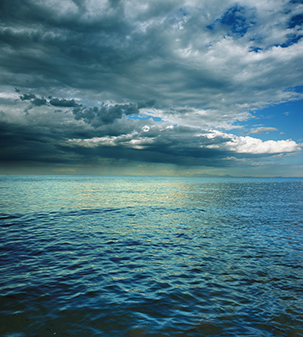
Salinity and Ocean Circulation
 Now you know why seawater is so salty. Seawater contains many dissolved substances, including salts. Rather than being uniform throughout, seawater's salinity varies from place to place due to changes in the amount of pure water present. Precipitation, runoff, melting icebergs, and evaporation contribute to these changes in salinity. Salt escapes seawater through the spray caused when waves crash against the shore, as well as into salt deposits within marine sediment.
Now you know why seawater is so salty. Seawater contains many dissolved substances, including salts. Rather than being uniform throughout, seawater's salinity varies from place to place due to changes in the amount of pure water present. Precipitation, runoff, melting icebergs, and evaporation contribute to these changes in salinity. Salt escapes seawater through the spray caused when waves crash against the shore, as well as into salt deposits within marine sediment.
Water on the ocean’s surface moves as a result of the Earth’s atmospheric winds. The rotation of Earth deflects these winds to the right or to the left depending on the hemisphere. This is called the Coriolis effect. Land masses, such as continents, interrupt water flow to cause five ocean circular gyres.
Surface currents are important because they distribute warm or cold water, and water temperature greatly influences the climate on land. The air and the sea are interconnected Earth systems. If the wind stops or reverses, climatic phenomenon such as El Niño and the Southern Oscillation can take place, followed by a La Niña pattern. Because of thermohaline circulation, water can also move under the ocean’s surface by differences in salinity and temperature of several different water masses. Deep ocean currents and surface currents are connected and sometimes called the oceanic conveyor belt to describe the redistribution of heat through water. This movement is critical to the climate of the globe.




